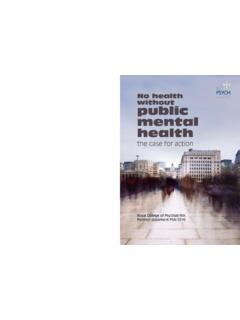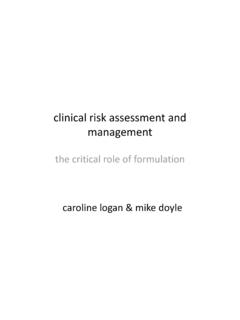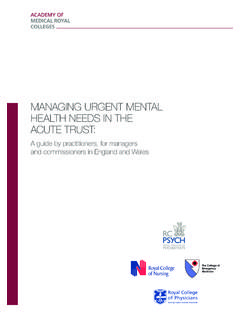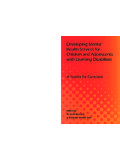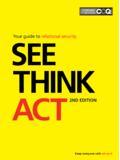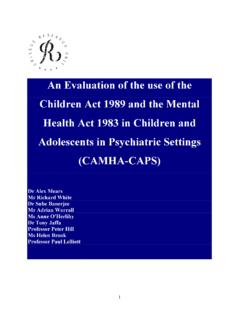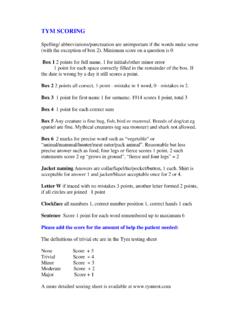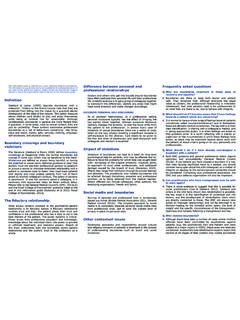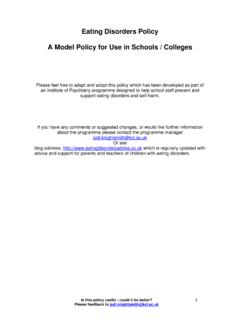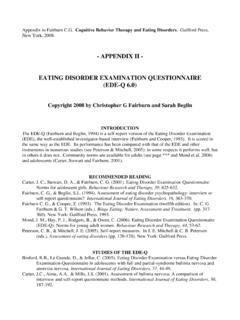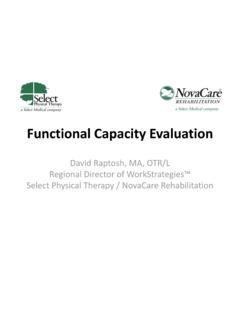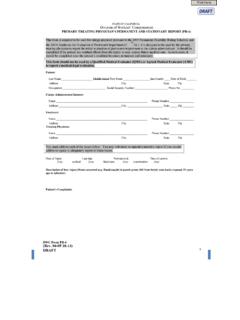Transcription of A developing service - Royal College of Psychiatrists
1 a developing service Cheshire and Wirral Partnership NHS Foundation Trust Mersey Care NHS Trust University of Liverpool ARD KP Neuro syndromes Brain injury Vascular disease Trauma Cerebella degeneration Central Pontine myelosis Marchiafava-bignami syndrome Subcortical frontal disorders Involuntary, jerky eye movements or paralysis of muscles moving the eyes Poor balance, staggering gait or inability to walk Drowsiness and confusion. 30% of alcohol misusers have ARD or cerebella damage (thiamine deficient) Diagnostic problems 18% of patients diagnosed during their life time 10% of WK patients have classical signs Estimated under diagnosis of 90% ~ of patients of the general population at post mortem ARBD is stigmatised; Self inflicted Low priority Double jeopardy; dementia and alcohol dependency Lack of professional responsibility for care Lack of training in medical professions Evidence of no clear clinical pathway Lack of commissioning of care Evidence drawn from brain injury, ARBD and alcohol treatment studies (no RCTs) There is likely to be variable cognitive recovery associated with abstinence provided the environment is correct.
2 Head injury and ARBD studies indicate that: Specific cognitive training enhances recovery and is generalisable to other cognitive domains. Ecologically driven rehabilitation is beneficial. Patients receiving specialised services fare better than those receiving generic services All three criteria should be positive 1. Probable history of heavy, long standing alcohol drinking: 35 units or more a week for at least five years. 2. Confusion, memory problems, doubt about capacity and concerns about risk on discharge, after withdrawal/physical stabilisation. 3. Thee or more admissions into hospital and/or A&E in one year probably associated either directly (withdrawal, unconscious) or indirectly (trauma, organ disease, etc.) with alcohol ingestion. Or One or more delayed discharges from general hospital wards in the last 12 months.
3 (a delayed discharge is defined as patients staying on the acute medical/surgical ward because of social and/or psychiatric problems). (Adapted through pilot work from Oslin s criteria relating to diagnosis of alcohol related dementia. (Oslin DW, Carey MS. Alcohol related dementia; Validation of diagnostic criteria. American Journal of Geriatric Psychiatry 2003;11(4):441-7. ) Funded by an innovation grant (NW SHA) Informed by evidence relating to rehabilitation of people with Acquired brain injury Alcohol related brain damage Alcohol misuse and dependency Designed for non specialised community teams working with non specialised nursing homes, community institutions and support services . Developed through: Small group education Supervision of cases Feedback through in depth interviews with patients Phase 1 Physical stabilisation (variable time) acute hospital management of encephalopathy, delirium tremens and withdrawal in the context of physical stabilisation and appropriate thiamine therapy (NICE 2010).)
4 Phase 2 Psycho-social assessment (usually 2-3 months:) Calm environment Early initiation of rehab programme Regularisation of sleep, appropriate nutritional maintenance and mood stabilisation Development of therapeutic relationships Early engagement with family and carers Phase 3 Therapeutic rehabilitation (lasts up to 2-3 years:) Ecologically relevant Milieu-based approach Adaptable environment 1. Dairy keeping 2. Activity scheduling 3. Graded task assignment memory and orientation cuing Phase 4 Adaptive rehabilitation (variable) adapting the environment so as to compensate for residual cognitive and functional deficits Phase 5 Social integration and relapse prevention (on-going) 42 year old women Found by police , unconscious, in a skip after sexual assaults No relatives Long standing drinking Multiple hospital admissions in acute medical/surgical hospitals.
5 Protracted malnutrition and chronic liver disease Previous periods of WE a year ago Admitted to medical ward GGT >1000 Physically stabilised: Psychiatry liaison; referred to service . Quite incapacitated with no insight Profound problems in learning new information Retrograde amnesia Varying confabulation Processing speed much reduced: leading to missing information Perceptual organisation low; difficulty in seeing the whole picture Graded naming was good Problem solving tests (behavioural assessment of dysexecutive syndrome): proneness to break rules, problems in planning Sentence completion is very poor due to inability to inhibit responses. Phase 2: CTO to specialised rehabilitation unit 6 months (out of area). Phase 2/3: Case specific commissioned package of care Placed in (Non specialised) mental health sheltered accommodation with additional support supervised rehab through team (CTO).
6 Very good progress, cognitive impairments improved, self catering in structured environment. Alcohol free General improvement in independence and memory. Rehabilitative support withdrawn Quality of life good, CTO closed Still requires supervised care but now able to shop and manage on a day to day basis 55 year old patient transferred from Liverpool to a house rented by his brother in Wirral so the patient can be looked after by his brother. Admitted to acute medical care as a consequence of uncontrolled convulsions. In an acute confusional state, went through withdrawal, GGT: 820 ACE-R score 23 (out of 100) Transferred from acute hospital to supported living for people with mental illness with additional carer support. Long term drinking with Many years of cognitive dysfunction.
7 No capacity or awareness of effects of alcohol on convulsions/cognitive state or physical state Highly suggestible with little reasoning and proneness to confabulate No cognitive capacity to manage personal funding Significant esophageal varicies and peripheral neuropathy Has little or no memories of previous few hours or recent events. Pre-occupation with alcohol access Two years later: ACE-R score 56; (23) Convulsions stabilised Settled in supported living Drinking two cans of larger a day Going out with brother regularly One hospital admission over night for convulsion Current status of rehab. Activity scheduling Targeted graded task assignment Problems Still no capacity to understand alcohol related problems: Cannot retain information Cannot understand what effects alcohol has on his physical and cognitive state Is very suggestible and vulnerable Finances still controlled by Brother, still engaged with advocate.
8 Objectives: To improve quality of life of ARBD sufferers To reduce admissions into acute medical/surgical care To develop local skills and services Population size: 300,000 The additional members of the team: One band six nurse One band 6 social worker (AMP) Approximately 2 patients a month 41 cases accepted and followed up for an average of 25 months (1-131) 11 female (average age ) 30 males (average age: ) All had experienced acute confusional states: Encephalopathy, delirium tremens/withdrawal confusion. 4 were admitted through medical intensive care; warranting intubation History of, or presentation with co-morbid physical conditions Number of patients History of, or presenting co-morbid mental illness Number of patients Unspecified encephalopathy 8 Depression 17 Convulsions 10 Aggression 8 Peripheral neuropathy 8 Cerebral ischaemic/infarcts 9 Upper motor neurone signs 3 Subdurals/ significant head trauma or anoxic brain damage 6 Cerebella signs 4 polydypsia 1 History of portal hypertension/oesophageal varicies 4 Bipolar affective disorder 1 Deep venous thrombosis 4 PTSD 1 Diabetes 4 Hoarding 1 Chronic urinary incontinence/renal disease 4 Heroine dependency (on methadone)
9 1 Hepatitis C positive 2 Heart failure/fibrillation 5 Pancreatic disease 2 Duodenitis/gastritis/ulcers 5 History of significant fractures/dislocations 6 Medical and psychiatric presentation/history Cerebro-vascular disease/head trauma in 1/3cases 1 patient went through PICU 5 patients on CTOs and one on guardianship ACE-R was carried out on a consecutive series of 22 of the 41 patients Conducted at of an average of 8 months into rehab programme: (3-12 months) group average ACE-R score was (range: 30-93, maximum score; 100) Group average Mini Mental State Examination score (incorporated within the ACE-R) was (range 11-30; maximum score 30) the individual with a score of 30 on the Mini Mental State Examination had a score of 93 on the ACE-R. This individual had clearly defined difficulty in higher order reasoning and memory.
10 The patient is currently held under guardianship of the mental health act. First three months (n=26) 10 : severe cognitive problems; hardly capable of the simplest tasks, with very poor memory, attentional problems and hardly able to learn new information. 13: suffering from moderate cognitive problems; including disorientation, attentional problems, organisational difficulties and difficulty in thinking clearly. 3 had either circumscribed cognitive deficits or milder impairment. 3 months to one year (n=12) 2: severe cognitive impairment. 4: patients had moderate cognitive impairment 6: milder cognitive impairment characterised by disorientation, difficulty in prioritising tasks, organisational issues and definite problems in learning new information.
